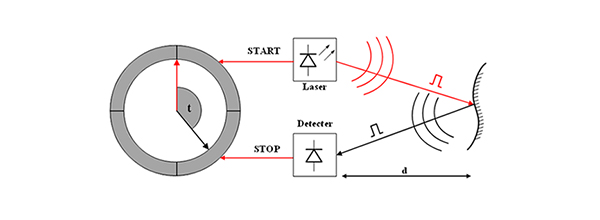XHS01

XHS01
There are two main ranging and imaging methods for Light detection and ranging (LiDAR) systems, namely, direct Time of Flight (dToF) and indirect Time of Flight (iToF). The operation principle of dToF is given in Fig.1. Periodic laser pulses are firstly emitted from laser sources, and the photoelectric sensor in the receiver will sense the laser echo reflected by the measured object and convert it into an electrical signal. The backend processing circuits will quantize and record the flight time. And then, the real distance can be simply calculated by multiplying the quantized time with light velocity. Compared to the iToF sensors (widely adopted in smart phones), the dToF sensors have much higher sensitivity, longer detection range, lower power consumption and stronger resistance to multi-path interference.

Fig1 Operation principle of dToF
As a sensor that measures the distance of objects by actively illuminating targets with laser pulses, the power of the laser sources in LiDAR system is limited by human eye safety and power consumption. For the long-range target, the intensity of reflected laser will greatly reduce with distances, even down to single-photon level. Single-photon avalanche diodes (SPAD), as its name indicates, can be trigged by weak light. In addition to that, SPADs have compact sizes and high sensitivity. Therefore, it is possible to integrate large number of SPADs and processing circuitry into a single chip, achieving multi-pixel 3D image sensors. Consequently, detection sensors based on SPADs can be adopted in wide range of applications (e.g. Mobile terminals, Smart homes, Smart transportation, Industrial robots and Autonomous driving). With the development of IC manufacturing process, SPAD-based dToF technique has already become an essential approach to implement compact and low-cost LiDAR systems.
XiLight will gradually launch a series of SPAD-based, high-performance dToF LiDAR sensors. These sensors adopt the Time-Correlated Single Photon Counting (TCSPC) technique, building histograms for each pixel based on the ToF information from the front-end and achieving long detection range. With a high single-shot precision, the dedicated TDC is suitable for the applications requiring high resolution (e.g. Proximity sensing). Combined with the proposed background noise suppression technique, reasonable detection range can be achieved even in the case of strong ambient light interference. Digital signal processors (DSP), image signal processors (ISP) and high-speed data output interface (such as MIPI) are also integrated in the LiDAR sensors, which meets the application needs of mobile devices, such as mobile phone.
Compared to the traditional linear-array rotating scanner LiDAR, Flash LiDAR gets rid of the mechanical parts. Therefore, the system structure is more compatible and reliable. The photodetectors and processing circuitry are both fabricated in the standard CMOS technology, highly increasing the integration level and reducing the hardware costs and area overhead.
Applications of XiLight Lidar sensor series:
 Consumer electronics (e.g. Mobile phone, Computer and other Internet of Things (IoT) devices)
Consumer electronics (e.g. Mobile phone, Computer and other Internet of Things (IoT) devices)
 Smart home
Smart home
 Intelligent robot
Intelligent robot
 Security
Security
 Autonomous driving/ Driving assistant
Autonomous driving/ Driving assistant
Features of the Lidar series:
 Long range detection
Long range detection
 High resolution
High resolution
 High frame rate
High frame rate
 Built-in preprocessing algorithm
Built-in preprocessing algorithm
 Low power consumption
Low power consumption


 0574-87300854
0574-87300854 info@xilight.tech (General Administration)
info@xilight.tech (General Administration)

